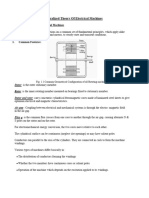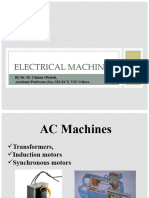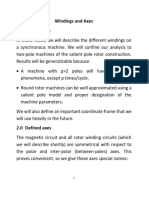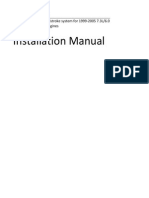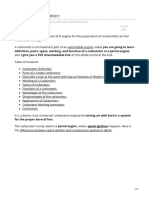Unit 4
Uploaded by
jansi_0102Unit 4
Uploaded by
jansi_0102Unit 3
Magnetic Flux in DC machines
u
f
/2
rotor
stator
I
f
S
N
V
f
+
-
.
.
.
.
.
.
x
x
x
x
x
x
Armature
Winding
I
f
u
a
mmf produced by the armature and mmf
produced by the field winding are
orthogonal.
Orthogonality of Magnetic Fields in
DC Machines
B
IL
F ( )
o
ILB L 90 sin = = B I F
Magnetic field due to
field winding
Magnetic field due to
armature winding
90
o
In all other machines (Reluctance,
Induction, Synchronous, Stepper motors,
PM motors, ) torque is produced as
result of one or more magnetic field which
rotate about the air gap
Magnetic Fields in other machines
3D=>2D presentation of AC
machines
stator
rotor
winding
stator
rotor
Two-Pole Single-Phase Stator
winding
Coils are placed in slots over the inner
circumference of the stator
Coils are connected in series with a
sinusoidal distribution
as
2
Rotor
Stator
s
|
as
1
as
2
as
3
as
1
as
3
as axis
+
-
as
1
as
1
as
2
as
2
as
3
as
3
i
as
v
as
Two-Pole Two-Phase Stator Winding
s
|
as
1
as
2
as
3
as
1
as
2
as
3
as axis
bs axis
bs
3
bs
2
bs
1
bs
1
bs
2
bs
3
+
-
+
-
bs
1
bs
2
bs
3
as
1
as
2
as
3
i
bs
i
as
v
as
v
bs
Stator windings are sinusoidally distributed
i
as
and i
bs
are sinusoidal current
waveforms generated by sinusoidal
sources v
as
and v
bs
The resulting mmf of the air gap:
mmf=i
as
N
as
+i
bs
N
bs
is approximated as a sinusoidal function of
|
s
Two-Pole Two-Phase Stator Winding
(cont.)
Approximate distribution of the as-
winding
s
|
|
s
= 0
as-axis
|
s
= t/2
Cross-sectional view of the
sinusoidal winding distribution
s p as s
s p as s
N N
N N
| t | t
| t |
sin 2 For
sin 0 For
= < <
= < <
Let N
s
represent the number of turns of the
equivalent sinusoidally distributed winding
p
s s p s
N
d N N
2
sin
0
=
}
=
t
| |
t/2 t 3t/2 2t
as-axis
|
s
conductors
Review - Magnetic circuits
u
u
u
N
i
V
l
g
l
i
A
Ni l H l H
g g i i
= +
H B =
i i i
A B = |
g g g
A B = |
i
i
i
A
B
|
=
g
g
g
A
B
|
=
g i g i
A A | | = = , Assume
Ni
A
l
A
l
g
i
g g
g
i i
i
= +
9
9
|
( ) mmf = = 9 + 9 Ni
j i
|
By definition mmf
as
is
positive for drop across
the air gap from rotor to
stator
mmf
as
positive at |
s
= 0
mmf
as
negative at |
s
= t
Air gap mmf
|
s
= t
|
s
= 0
as-axis
|
s
= -t/2
( )
( )
as
s
s as
as
s
s as
i
N
i
N
2
mmf
2
0 mmf
= =
= =
t |
|
( )
( ) 0 mmf
0 mmf
2
2
= =
= =
t
t
|
|
s as
s as
s as
s
as
i
N
| cos
2
mmf =
For the above, the net
current enclosed is
zero, and the mmf drop
is zero along the path
Air gap mmf
|
s
= t/2
|
s
= 0
|
s
= -t/2
Therefore:
as-axis
Two-Pole reluctance machines
as axis
u
r
e
r
as
as
as axis
u
r
e
r
as
as'
bs bs'
bs axis
Single phase Two phase
Two-Pole reluctance machines
Stator windings are assumed to be sinusoidally
distributed
For single phase machines excited by an AC
current source, the generated flux wave has two
opposite rotating mmf
s
(These motors are used
in clocks and some other turntables)
( )
( )
|
|
.
|
\
|
+ + +
+
=
s esi e s
s esi e s
s
s
t I
t I
N
| u e
| u e
) 0 ( cos
) 0 ( cos
2
2
mmf
2
1
2
1
( ) ) 0 ( cos 2
mmf
esi e as as
as as as
t i i
i N
u e + =
=
term results in
counterclockwise (positive) travelling wave
term results in clockwise
(negative) travelling wave
Two-Pole reluctance machines
( )
s esi e
t | u e + ) 0 ( cos
dt
d
s
e
|
e =
( )
s esi e
t | u e + + ) 0 ( cos
e
s
dt
d
e
|
=
Two-Pole reluctance machines
For reluctance machine (Fig. 1),
( )
r B A l asas
L L L L u 2 cos + =
( )
r
r as c
e
i W
T
u
u
c
c
=
,
( ) ( )
2
2
1
2 cos
as r B A l c
i L L L W u + =
( )
r as B r as e
i L i T u u 2 sin ,
2
=
Two-Pole reluctance machines
For two-phase reluctance machines (see Fig.1), only one
constant-amplitude rotating air gap mmf is produced
during balanced steady state conditions
Two-phase reluctance machines develop a constant
torque at synchronous speed rather than a torque which
pulsates about an average value as is the case with
single-phase machines
( )
s esi e s
s
s
t I
N
| u e + = ) 0 ( cos 2
2
mmf
2 = = p
dt
d
e
s
e
|
Two-pole induction machines
as axis
ar axis
as
as'
ar
ar'
u
r
|
s
e
r
|
r
as axis
ar axis
as
as'
ar
ar'
u
r
|
s
e
r
|
r
br
br'
bs bs'
bs axis
br axis
Single phase
Two phase
Cutaway Views of Squirrel-cage
Induction Motor
Single and two pole induction machines have
identical equivalent orthogonal windings which are
sinusoidally distributed (see Fig.2)
Rotor windings are short-circuited
Single-phase induction machines are widely used
(washers, dryers, furnace fans, etc.)
Recall:
Two-pole induction machines
s as
s
as
i
N
| cos
2
mmf =
( ) ) 0 ( cos 2
esi e s as
t I i u e + =
( )
( )
|
|
.
|
\
|
+ + +
+
=
s esi e s
s esi e s
s
as
t I
t I
N
| u e
| u e
) 0 ( cos
) 0 ( cos
2
2
mmf
2
1
2
1
Two-pole induction machines
Term #1: positive travelling flux wave
Term #2: negative travelling flux wave
Recall:
Single-phase induction machines do not develop a
starting torque. At the start u
r
=0, T
e
=0, i.e at start the
rotor cannot follow either of the rotating mmfs since it
develops as much torque to go in either direction
Single-phase induction motors have two stator
windings with provision to switch out one of the
windings once the rotor accelerates to between 60 to
80 percent of synchronous speed
e
s
dt
d
e =
|
e
s
dt
d
e =
|
( )
r as B r as e
i L i T u u 2 sin ,
2
=
Two-pole induction machines
To provide two phase power from one phase power
supply, a capacitor is used during the starting.
r r s
r ar
r
ar
i
N
u | |
|
+ =
= cos
2
mmf
( ) ( )
( ) ( )
|
|
.
|
\
|
| + u + e e +
| u + e e
=
r eri r e
r eri r e
r
r
ar
t
t
I
N
) 0 ( cos
) 0 ( cos
2
2
mmf
2
1
2
1
Two-pole induction machines
For two-phase induction machines, stator
mmf
s
is a positive travelling flux wave which rotates
around the air gap at a speed of e
e
(see Fig.2b)
Machine rotor windings are short-circuited
( )
s esi e s
s
s
bs as s
t I
N
| u e + =
+ =
) 0 ( cos 2
2
mmf
mmf mmf mmf
r r s
r br
s
br
r ar
s
ar
i
N
i
N
u | |
|
|
+ =
=
=
cos
2
mmf
cos
2
mmf
Two-pole induction machines
Current flowing in the rotor windings will be due to
induction with a frequency of e
e
- e
r
. The rotor
currents, i
ar
and i
br
will produce an air gap mmf that
travels at a speed of e
e
- e
r
relative to the rotor or e
e
relative to a stationary observer.
Interactions of mmf
r
due to rotor and mmf
s
due to
stator will produce torque on the rotor.
( ) ( ) ( )
r eri r e r
r
r
t I
N
| u e e + = ) 0 ( cos 2
2
mmf
dt
d
J T T
m
ex em
e
=
Three-phase induction machines
as'
as
bs
bs'
as - axis
bs - axis
cs
cs'
cs - axis
ar - axis
br - axis
cr - axis
br
ar'
br'
cr
cr'
ar
T
l
|
s
|
r
u
r
e
r
T
e
Three-phase induction machines
Three-phase induction machines have three identical
sinusoidally distributed stator and rotor windings. The
magnetic axes of the windings are displaced 120
o
from each other and rotor windings are short-circuited
(see Fig.3)
( )
s esi e s
s
s
cs bs as s
t I
N
| u e + =
+ + =
) 0 ( cos
2
3
2
2
mmf
mmf mmf mmf mmf
( ) ( )
r eri r e r
r
r
cr br ar r
t I
N
| u e e + =
+ + =
) 0 ( cos
2
3
2
2
mmf
mmf mmf mmf mmf
Three-phase induction machines
mmf
s
is a positive travelling flux wave which rotates
around the air gap at a speed of e
e
.
mmf
r
is a positive travelling flux wave which rotates
around the air gap at a speed of e
e
-e
r
relative to the
rotor.
Interactions of mmf
r
due to rotor and mmf
s
due to
stator will produce torque on the rotor.
Three-phase induction machines -
dq axis
as - axis
bs - axis
cs - axis
ar - axis
br - axis
cr - axis
|
s
|
r
u
r
q - axis
d - axis
|
u
r r s
r
u | |
u u |
+ =
=
You might also like
- CEM-CE-1006 Cement Equipment Basic - Student Guide PDF100% (1)CEM-CE-1006 Cement Equipment Basic - Student Guide PDF236 pages
- Lithium Ion Battery Identification ReferenceNo ratings yetLithium Ion Battery Identification Reference5 pages
- Electrical Machines: CM2 - Rotating FieldsNo ratings yetElectrical Machines: CM2 - Rotating Fields45 pages
- Indection Motor: Mechanical Engineer 3ANo ratings yetIndection Motor: Mechanical Engineer 3A33 pages
- Induction Machines - Asynchronous MachinesNo ratings yetInduction Machines - Asynchronous Machines43 pages
- Lecture: Energy Systems - 2: Instructor Prof. B. G. FernandesNo ratings yetLecture: Energy Systems - 2: Instructor Prof. B. G. Fernandes20 pages
- Induction Motor Steady-State Model: SEE 3433 Mesin ElektrikNo ratings yetInduction Motor Steady-State Model: SEE 3433 Mesin Elektrik38 pages
- Eletrical Machines (K-Wiki - Synchronous Machines)100% (1)Eletrical Machines (K-Wiki - Synchronous Machines)59 pages
- 7 Magnetic Fields in Electrical MachinesNo ratings yet7 Magnetic Fields in Electrical Machines17 pages
- 1-Phase Induction Motor Notes - 06.04.2022No ratings yet1-Phase Induction Motor Notes - 06.04.202253 pages
- Electromechanical Systems: Asinchronous (Induction) MachinesNo ratings yetElectromechanical Systems: Asinchronous (Induction) Machines35 pages
- Chapter5 Three Phase Induction Motor AsyNo ratings yetChapter5 Three Phase Induction Motor Asy35 pages
- 6.061 Class Notes, Chapter 9_ Synchronous Machine and Winding ModelsNo ratings yet6.061 Class Notes, Chapter 9_ Synchronous Machine and Winding Models24 pages
- 3 Phase Induction Machine: Squirrel Cage Induction Motor Wound Rotor Induction Motor100% (4)3 Phase Induction Machine: Squirrel Cage Induction Motor Wound Rotor Induction Motor28 pages
- Lecture 2 - Electrical Machines .PPT (Compatibility Mode) - 1No ratings yetLecture 2 - Electrical Machines .PPT (Compatibility Mode) - 117 pages
- EEE - Electrical Machines II - Mrs. Anitha Sampath KumarNo ratings yetEEE - Electrical Machines II - Mrs. Anitha Sampath Kumar20 pages
- Electrical-Machines-2-AC-Machines-1-102No ratings yetElectrical-Machines-2-AC-Machines-1-10299 pages
- Fundamentals of Electronics 1: Electronic Components and Elementary FunctionsFrom EverandFundamentals of Electronics 1: Electronic Components and Elementary FunctionsNo ratings yet
- A New System of Alternating Current Motors and Transformers and Other EssaysFrom EverandA New System of Alternating Current Motors and Transformers and Other Essays5/5 (1)
- Robot Manipulators: Modeling, Performance Analysis and ControlFrom EverandRobot Manipulators: Modeling, Performance Analysis and ControlNo ratings yet
- Training & Devlopment in NTPC - Shreya Gupta100% (1)Training & Devlopment in NTPC - Shreya Gupta76 pages
- POWER QUALITY AND FACTS Question Paper 21 22No ratings yetPOWER QUALITY AND FACTS Question Paper 21 223 pages
- AMNS Boldrocchi ENDA 5800 SO2, NO, CO, Co2, O2 DrawingNo ratings yetAMNS Boldrocchi ENDA 5800 SO2, NO, CO, Co2, O2 Drawing7 pages
- COMS PUB 0021 - A Roadmap For Indonesia - S Power SectorNo ratings yetCOMS PUB 0021 - A Roadmap For Indonesia - S Power Sector64 pages
- MR - SLIM With Heat Pump Lineup Catalogue: InverterNo ratings yetMR - SLIM With Heat Pump Lineup Catalogue: Inverter20 pages
- Physics Challenge For Teachers and Students: Solutions To January 2007 ChallengeNo ratings yetPhysics Challenge For Teachers and Students: Solutions To January 2007 Challenge2 pages
- CFP33-F30 - F20 - F10 - Material of ConstructionNo ratings yetCFP33-F30 - F20 - F10 - Material of Construction1 page
- CEM-CE-1006 Cement Equipment Basic - Student Guide PDFCEM-CE-1006 Cement Equipment Basic - Student Guide PDF
- Lecture: Energy Systems - 2: Instructor Prof. B. G. FernandesLecture: Energy Systems - 2: Instructor Prof. B. G. Fernandes
- Induction Motor Steady-State Model: SEE 3433 Mesin ElektrikInduction Motor Steady-State Model: SEE 3433 Mesin Elektrik
- Eletrical Machines (K-Wiki - Synchronous Machines)Eletrical Machines (K-Wiki - Synchronous Machines)
- Electromechanical Systems: Asinchronous (Induction) MachinesElectromechanical Systems: Asinchronous (Induction) Machines
- 6.061 Class Notes, Chapter 9_ Synchronous Machine and Winding Models6.061 Class Notes, Chapter 9_ Synchronous Machine and Winding Models
- 3 Phase Induction Machine: Squirrel Cage Induction Motor Wound Rotor Induction Motor3 Phase Induction Machine: Squirrel Cage Induction Motor Wound Rotor Induction Motor
- Lecture 2 - Electrical Machines .PPT (Compatibility Mode) - 1Lecture 2 - Electrical Machines .PPT (Compatibility Mode) - 1
- EEE - Electrical Machines II - Mrs. Anitha Sampath KumarEEE - Electrical Machines II - Mrs. Anitha Sampath Kumar
- Analog Dialogue, Volume 48, Number 1: Analog Dialogue, #13From EverandAnalog Dialogue, Volume 48, Number 1: Analog Dialogue, #13
- Computer Numerical Control Programming BasicsFrom EverandComputer Numerical Control Programming Basics
- Fundamentals of Electronics 1: Electronic Components and Elementary FunctionsFrom EverandFundamentals of Electronics 1: Electronic Components and Elementary Functions
- A New System of Alternating Current Motors and Transformers and Other EssaysFrom EverandA New System of Alternating Current Motors and Transformers and Other Essays
- O level Physics Questions And Answer Practice Papers 2From EverandO level Physics Questions And Answer Practice Papers 2
- Exercises in Electronics: Operational Amplifier CircuitsFrom EverandExercises in Electronics: Operational Amplifier Circuits
- O level Physics Questions And Answer Practice Papers 3From EverandO level Physics Questions And Answer Practice Papers 3
- Robot Manipulators: Modeling, Performance Analysis and ControlFrom EverandRobot Manipulators: Modeling, Performance Analysis and Control
- AMNS Boldrocchi ENDA 5800 SO2, NO, CO, Co2, O2 DrawingAMNS Boldrocchi ENDA 5800 SO2, NO, CO, Co2, O2 Drawing
- COMS PUB 0021 - A Roadmap For Indonesia - S Power SectorCOMS PUB 0021 - A Roadmap For Indonesia - S Power Sector
- MR - SLIM With Heat Pump Lineup Catalogue: InverterMR - SLIM With Heat Pump Lineup Catalogue: Inverter
- Physics Challenge For Teachers and Students: Solutions To January 2007 ChallengePhysics Challenge For Teachers and Students: Solutions To January 2007 Challenge


















